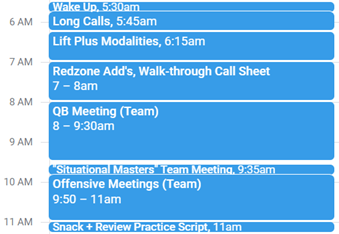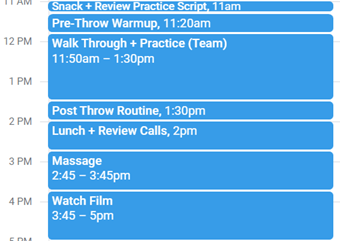A Week as an NFL Quarterback: Friday

As an NFL quarterback, in-season, you work seven days a week. Friday, on a relative basis, is one of the shorter days and as a result, earns the league-wide nickname “Fast Friday”. To my knowledge, the majority of NFL teams participate in this scheduling, with required team activities ending around 1:30 p.m. I humbly thank whoever came up with the idea.
On this day, teams concurrently attack two objectives: (1) install the redzone game plan and (2) review and tweak the plays installed on Wednesday and Thursday. At this point in the week, you should have a strong understanding of the upcoming opponent and the plan to attack their weaknesses.
In this post, you will be taken through a schedule, hour by hour, of what a Friday is actually like for an NFL quarterback.
But first, a few notes to level-set before I begin:
1. For context, and so I do not have to redefine football jargon, I take the assumption you have read my posts on Wednesday and Thursday as an NFL QB. I recommend starting with Wednesday and working forward from there. Wednesdays to NFL players, are Monday’s to most of the world.
2. “(Team)” in the screengrabs of my schedule means mandatory meeting/practice. If not parenthesized with “(Team)” then I am personally scheduling that activity.
3. This post avoids using proprietary Rams terminology and information.
If you're interested in QB specific throwing, lifting and sprint training, customized to you, with the same systems used to train NFL Quarterbacks, take the assessment and get the app at kinetex.co. If you're interested in reading about all things quarterbacking and throwing biomechanics, subscribe to the blog.
Morning
Here’s a look at my morning schedule:

5:45-6:15 am
Play calls on the drive in (via voice memo): 5:45 am is a broken record for me Wednesday, Thursday and Friday. A detailed explanation of how I leverage voice recordings to gain mental reps is on the Wednesday blog.
6:15-7:00 am
Lift plus modalities: Practice squad players have an extra lift on Friday’s, while players on the 53 man roster do not. My first year in the league, I remember getting slaughtered on the assault bike at those p-squad lifts and, ever since, I have maintained the habit of getting a third lift in. In sharp contrast to my first year, this lift is much less intense, and is specifically designed to allow me to feel good on Sunday. Post lift, I hit three modalities: (1) t-spine mobility (2) ankle stability and (3) breathing exercises with sunlight.
7:00-8:00 am
Redzone Additions plus walk-through call sheet: Welcome to my Friday office. Sequestered in the back of the Ram’s facility is a windowless, vacant office that I frequent to work in silence. You’ll find me here on Friday’s starting the hour with a review of the redzone game plan. These plays are additions to the existing plan that are used solely in the redzone. After reviewing, I add them to my voice memos. I then do a walkthrough of the entire gameplan. This process is as follows:
1. Play a voice memo on my phone and hear a play call. For example, flack to deuce rt claw z short panama x revo z tong (can) 3 jet f-astro x-cleaner.
2. I pause the recording, much like the microphone stops talking in my helmet, and call the play as if I’m in the huddle.
3. I then turn, much like breaking the huddle, and visualize a defense. Based on what I visualize I go through whether or not I would “can” (audible the play).
4. To finish, I go through my footwork and progressions like I’m in the game (I scale the footwork down so I don’t run through a wall).
8:00-9:25 am
QB meeting: I shuffle over to the centrally located QB meeting room with the focus of the meeting as follows:
1. Review yesterday’s practice.
2. Go through anticipated redzone coverages and the corresponding plays to attack them.
3. Go through any additions and tweaks to the normal down and distance plan and third down plan.
9:35-9:50 am
“Situational Masters” Team Meeting: The entire team matriculates into our largest meeting room for this meeting. Our special teams coordinator, Joe DeCamillis, pulls up a slideshow with corresponding game clips demonstrating how to play great situational football. For example:
There are eight seconds left in the game, you are up by seven and it is fourth down so you have to punt. It is much safer to tell your punter to catch the snap, sprint to your own endzone and take as much time as possible off the clock before intentionally taking a safety. Ideally this takes all eight seconds and the game is over. Worst case, he is pushed out with two seconds left, and you punt-kickoff to the opposing team with no risk of it getting blocked.
This is one example, but throughout the course of the year he covers every situation. The clips he shows are comical, as they entail recent games where NFL and college teams exhibit awful situational football in hopes we learn from their mistakes. It should be noted that he shows positive examples as well, but I find the disaster examples much more entertaining.
9:50-11:00 am
Offensive meeting: For this offensive meeting, which includes all skill position players, we are re-reviewing two objectives that we already hit in the quarterback meeting. But this time, as Liam or Sean presents, the entire group from coaches to quarterbacks to skill players, are interactively communicating the nuances of the plays to ensure everyone is on the same page. The two things we cover again are:
1. Anticipated redzone coverages and the corresponding plays to attack them.
2. Any tweaks or additions to plays in the normal down and distance and third down gameplans.
Defensive coverage structure’s change once you pass their 20 yd line. We cover in detail what coverages they deploy inside the 20, 10, and 5 yd line in this meeting. For example, they may play standard coverage at the 20-yard line but inside the five they bring in an extra d-lineman and play cover 0 (all-out blitz), so the offense can’t run the ball easily and the quarterback has to complete a contested throw, under duress, with minimal vertical grass. If they are a cover 0 team, then we need to have plays ready to exploit that tendency.
Afternoon
Here’s my schedule:

11:00-11:15 am
Snack plus review practice script: Preparation time for practice is abbreviated on Friday’s. I grab a quick snack, think yogurt or fruit, and review the practice plan quickly.
11:20-11:50 am
Pre-throw routine: I discussed this in the Wednesday post put as a reminder this routine works to:
1. Induce blood flow through the body and rotator cuff to prepare for high velocity throwing.
2. Ensure my throwing motion is properly sequenced.
3. Ramp up my nervous system to feel fresh on the practice field.
11:50-1:30 pm
Walk through plus practice: On Fast Fridays, we combine the walk through and practice into one scheduled block. The focus of both is redzone, with the leniency to practice plays in the third down and normal down and distance menu as needed. Practice is quicker and less intense so our bodies will peak on Sunday.
1:30-2:00 pm
Post-throw routine: I mosey into the weight room post practice, death metal playing, while some of the guys hammer an arm circuit so they can look jacked on Sunday. My standard sized arms have a different plan, and just like Wednesday and Thursday, I hit my post-throw routine. As a reminder this routine is designed to flush the tissue and re-stabilize the joints associated with throwing.
2:00-2:45 pm
Lunch plus review calls: Food Truck Friday. Every Friday, outside the locker room, the Rams bring in a local food truck which I grab lunch from, and then start my drive to a massage spot close to my house. On the road, I go through all the play calls via my voice memos.
2:45-3:45 pm
Massage: I get a massage.
3:45-5:00 pm
Watch Film: I re-watch the normal down and distance cutups (1st and 2nd down) plus buzz the protection cutup which I discussed in the Thursday blog. Late in the week, watching film is expedited and my process is as follows:
1. I start watching a play, pause it right at the snap, and hypothesize the coverage or blitz.
2. After step one, I hit play for a quick second to see if I was correct. Rinse, repeat.
Earlier in the week, I am watching the entirety of the plays. Later in the week, I am testing myself.
Night
5:00-9:00 pm
Downtime: No need for a screengrab. Friday nights the schedule is clear. Sometimes it’s dinner with friends, other times it’s a book or a movie. Either way, I am exhausted and there is a high probability I pass out early.
If you're interested in QB specific throwing, lifting and sprint training, customized to you, with the same systems used to train NFL Quarterbacks, take the assessment and get the app at kinetex.co. If you're interested in reading about all things quarterbacking and throwing biomechanics, subscribe to the blog.
